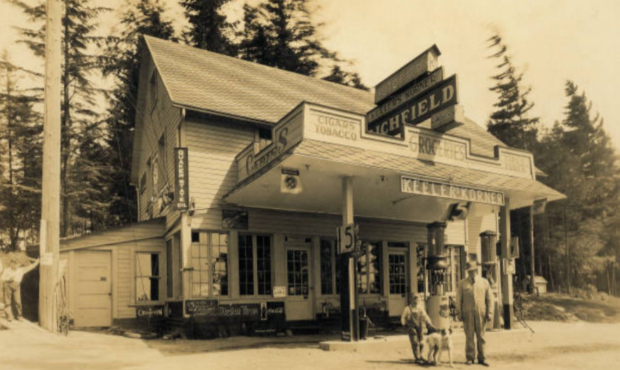All Over The Map: Do any ‘classic’ 1960s or 1970s service stations survive?
Jul 17, 2020, 3:36 PM | Updated: Jul 20, 2020, 9:30 am

Keeler's Corner gas station was built along Highway 99 in what's now Lynnwood in the late 1920s and still stands; examples of later "classic" service stations from the 1960s and 1970s can be even harder to find. (Everett Public Library)
(Everett Public Library)
Even with the pandemic, late July still means getting out on the highway for that timeless tradition of a summer road trip. And while you can’t take part in this timeless tradition without service stations along the way – it seems like the recent history of a certain kind of service station is disappearing in the rear-view mirror of the past.
By some accounts, the service station was invented in Seattle in 1907 by a gasoline dealer named John McLean. He added a few other products and amenities for his gas customers at his retail outlet south of downtown. It can be tough to find, but a plaque west of State Route 99, just south of the tunnel, marks the spot where McLean made customer-service history.
Here and there along Washington’s vintage roadways remain some notable specimens of classic early service stations. Though none of these well-known examples are still selling gas, they remain visible to motorists and to those who pull over to take a closer look.
The Teapot Dome gas station near Zillah is teapot shaped. It opened in 1922 in honor of a scandal in the Warren G. Harding administration. It was moved once for highway construction in the 1970s, and moved again in 2012 to a park in downtown Zillah where it now serves as a visitor center.
Keeler’s Corner opened in the late 1920s when Highway 99 through Lynnwood was the main north-south route between Mexico and Canada. At last check, the building was still standing on the east side of the old highway at 164th. It’s been an antique store in the recent past, but it’s unclear what’s there now.
The Hat & Boots opened in 1955 as “Premium Tex” at Frontier Village on East Marginal Way north of Boeing Field. The cowboy hat was the office, and the cowboy boots were the restrooms. Since they were moved a few blocks east in 2003, they’ve served as giant lawn ornaments at Oxbow Park in Georgetown.
While this handful of stations and others that date back 65 years or more have justifiably earned the attention of preservationists, it seems that more recent “classic” service stations – those built in the 1960s and 1970s as corporate franchises for brands like Enco, Richfield, Texaco, or Shell – have not yet received similar focus.
And what comes to mind when we think of “classic” 1960s and 1970s service stations?
Just about anyone over the age of 45 can probably remember.
The lobbies had clean-ish restrooms and free road maps, and maybe a gumball machine – the little glass orb variety, often topped with a placard featuring a blue-tinted photo of a little girl on crutches, since, somehow, all those pennies were helping a charity somewhere.
And you could get your car fixed at a service station like this, as they typically had mechanics on duty on weekdays and at least two service bays with hydraulic lifts. Often, there were dozens of varieties and sizes of fan belts suspended from the ceiling, and the attendant had a long wooden stick with a nail on the end to retrieve the highest-hanging rubber fruit.
With this era of service station, there was no “minimart” — with a hotdog roller, soft-serve machine, or anything like that – anywhere on the premises. About the only thing you could buy besides gas was a quart of oil or maybe a battery.
A great example from the movies is the remote, rural service station that Jonathan Winters’ character destroys in the classic 1963 film, “It’s a Mad, Mad, Mad, Mad World.”
Most of the stations like this in rural and urban areas are gone, of course, not because of Jonathan Winters, but because the economics of service stations changed as car repairs became more complex, and because convenience stores and gas stations came to be a good fit as people spent more and more time commuting in their cars. By the early 1980s, many of these stations began to morph from full-service, service stations into minimarts that happened to have gas pumps out front.
In Seattle, a notable example of surviving actual service stations – that sell gas and do repairs – are operated by Salmon’s Service, with locations in Greenwood, Ravenna, and Lake City. The company’s website says the family has been in business since 1951, though the service station buildings themselves appear to have been upgraded or rebuilt more recently than the 1960s or 1970s.
KIRO Radio reached out on Thursday to the Washington Oil Marketers Association (WOMA) for assistance finding other examples like this that might still exist among their membership in the Evergreen State.
Dan Averill, president of WOMA, said in an email that finding other examples was unlikely.
“The branded oil companies (Shell, Chevron, Texaco and such),” Averill wrote, “require that the service stations/convenience stores meet their image requirements in order to maintain the brand.”
Thus, the chances of finding unaltered examples of real service stations, still resplendent in all their original clean-ish restroom and free-map glory, are pretty slim.
However, if you know of any examples of 1960s/1970s service stations in Washington – or other classic service stations from any era – please email me via my contact information below, and send a photo of the service station if you can.
You can hear Feliks every Wednesday and Friday morning on Seattle’s Morning News and read more from him here. If you have a story idea, please email Feliks here.













